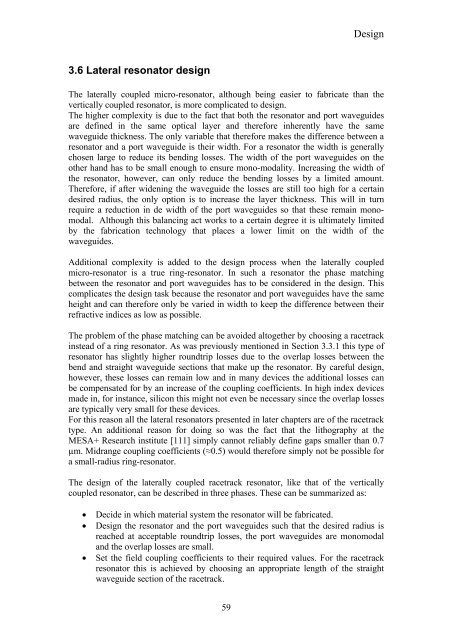Edwin Jan Klein - Universiteit Twente
Edwin Jan Klein - Universiteit Twente
Edwin Jan Klein - Universiteit Twente
Create successful ePaper yourself
Turn your PDF publications into a flip-book with our unique Google optimized e-Paper software.
3.6 Lateral resonator design<br />
59<br />
Design<br />
The laterally coupled micro-resonator, although being easier to fabricate than the<br />
vertically coupled resonator, is more complicated to design.<br />
The higher complexity is due to the fact that both the resonator and port waveguides<br />
are defined in the same optical layer and therefore inherently have the same<br />
waveguide thickness. The only variable that therefore makes the difference between a<br />
resonator and a port waveguide is their width. For a resonator the width is generally<br />
chosen large to reduce its bending losses. The width of the port waveguides on the<br />
other hand has to be small enough to ensure mono-modality. Increasing the width of<br />
the resonator, however, can only reduce the bending losses by a limited amount.<br />
Therefore, if after widening the waveguide the losses are still too high for a certain<br />
desired radius, the only option is to increase the layer thickness. This will in turn<br />
require a reduction in de width of the port waveguides so that these remain monomodal.<br />
Although this balancing act works to a certain degree it is ultimately limited<br />
by the fabrication technology that places a lower limit on the width of the<br />
waveguides.<br />
Additional complexity is added to the design process when the laterally coupled<br />
micro-resonator is a true ring-resonator. In such a resonator the phase matching<br />
between the resonator and port waveguides has to be considered in the design. This<br />
complicates the design task because the resonator and port waveguides have the same<br />
height and can therefore only be varied in width to keep the difference between their<br />
refractive indices as low as possible.<br />
The problem of the phase matching can be avoided altogether by choosing a racetrack<br />
instead of a ring resonator. As was previously mentioned in Section 3.3.1 this type of<br />
resonator has slightly higher roundtrip losses due to the overlap losses between the<br />
bend and straight waveguide sections that make up the resonator. By careful design,<br />
however, these losses can remain low and in many devices the additional losses can<br />
be compensated for by an increase of the coupling coefficients. In high index devices<br />
made in, for instance, silicon this might not even be necessary since the overlap losses<br />
are typically very small for these devices.<br />
For this reason all the lateral resonators presented in later chapters are of the racetrack<br />
type. An additional reason for doing so was the fact that the lithography at the<br />
MESA+ Research institute [111] simply cannot reliably define gaps smaller than 0.7<br />
µm. Midrange coupling coefficients (≈0.5) would therefore simply not be possible for<br />
a small-radius ring-resonator.<br />
The design of the laterally coupled racetrack resonator, like that of the vertically<br />
coupled resonator, can be described in three phases. These can be summarized as:<br />
• Decide in which material system the resonator will be fabricated.<br />
• Design the resonator and the port waveguides such that the desired radius is<br />
reached at acceptable roundtrip losses, the port waveguides are monomodal<br />
and the overlap losses are small.<br />
• Set the field coupling coefficients to their required values. For the racetrack<br />
resonator this is achieved by choosing an appropriate length of the straight<br />
waveguide section of the racetrack.















